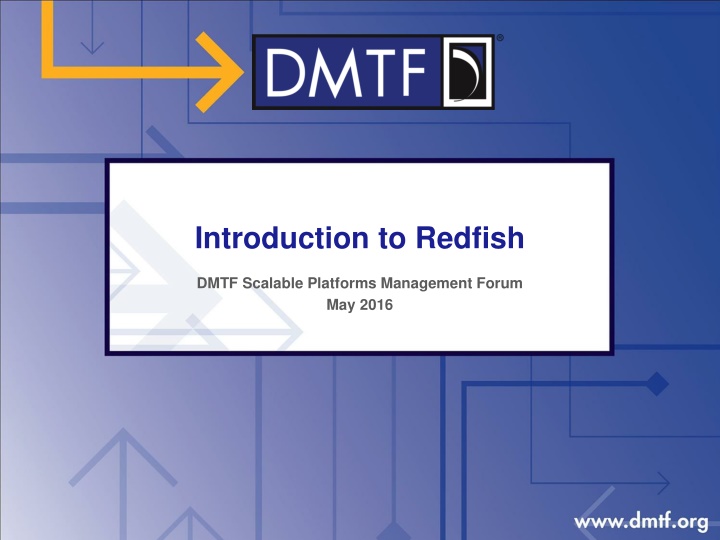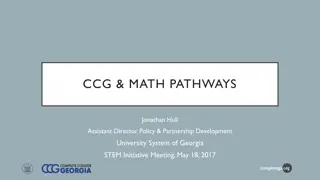Introduction to Redfish
Redfish is an industry standard RESTful API for IT infrastructure, providing a secure and versatile way to manage servers and other components. The forum, co-chaired by leaders from prominent companies, aims to expand the scope of Redfish and collaborate with industry partners to enhance machine management. Learn about the benefits of REST, HTTP, and JSON in this evolving platform.
Download Presentation

Please find below an Image/Link to download the presentation.
The content on the website is provided AS IS for your information and personal use only. It may not be sold, licensed, or shared on other websites without obtaining consent from the author.If you encounter any issues during the download, it is possible that the publisher has removed the file from their server.
You are allowed to download the files provided on this website for personal or commercial use, subject to the condition that they are used lawfully. All files are the property of their respective owners.
The content on the website is provided AS IS for your information and personal use only. It may not be sold, licensed, or shared on other websites without obtaining consent from the author.
E N D
Presentation Transcript
Introduction to Redfish DMTF Scalable Platforms Management Forum May 2016
Disclaimer The information in this presentation represents a snapshot of work in progress within the DMTF. This information is subject to change without notice. The standard specifications remain the normative reference for all information. For additional information, see the Distributed Management Task Force (DMTF) website. 2
What is Redfish? Industry Standard RESTful API for IT Infrastructure HTTPS in JSON format based on Odata v4 Equally usable by Apps, GUIs and Scripts Schema-backed but human-readable Version 1 focused on Servers A secure, multi-node capable replacement for IPMI-over-LAN Add devices over time to cover customer use cases & technology PCIe Switching, Local Storage, NVDIMMs, Multifunction Adapters, Composability Intended to meet OCP Remote Machine Management requirements Expand scope over time to rest of IT infrastructure Working with SNIA to cover more advanced storage. Plan on working with partners like the Green Grid to cover Power/Cooling Goal is to accommodate or map existing switch standards over time.
Scalable Platforms Management Forum (DMTF Group that Defines Redfish) Co-Chairs: Jeff Autor (HPE), Paul Vancil (Dell) Leadership Companies Supporting Companies AMI, Cisco, Fujitsu, Western Digital, Huawei, IBM, Insyde Software, Mellanox, NetApp, Oracle, Microsemi, Qualcomm, Seagate Industry Alliance Partners OpenCompute Project UEFI - Collaborating on Firmware Update and Host Interface work SNIA Collaborating on Storage modeling / alignment between SSM and Redfish TGG Pursuing relationship to work on Power/Cooling (existing DMTF Alliance Partner) March 5, 2025 4
Why REST, HTTP and JSON? REST: The API architecture Rapidly replacing SOAP HTTPS: The Web protocol Well-understood by admins Known security model Known network configuration JSON: Modern data format Human-readable Simpler than XML Modern language support The combination of language support and ubiquity of REST, HTTP and JSON means that systems management tasks can be performed using the same skill set and tool chain as all other IT and dev/ops tasks. 5
How simple is REST using JSON? Example Python code to retrieve serial number from a server: rawData = urllib.urlopen( http://192.168.1.135/redfish/v1/Systems/1 ) jsonData = json.loads(rawData) print( jsonData[ SerialNumber ] ) Output is: 1A87CA442K *Example uses Redfish ComputerSystem resource, Authentication not shown 6
Redfish v1.0 Feature Set Retrieve IPMI class data Basic server identification and asset info Health state Temperature sensors and fans Power supply, power consumption and thresholds Perform Common Actions Reboot / power cycle server Change boot order / device Set power thresholds Basic I/O infrastructure data Host NIC MAC address(es) for LOM devices Simple hard drive status / fault reporting Access and Notification Serial console access via SSH Alert / event notification method(s) Event Log access method(s) Discovery Service endpoint (network-based discovery) System topology (rack/chassis/server/node) BMC infrastructure View / configure BMC network settings Manage local BMC user accounts Security Session-based leverages HTTPS Working on more
Redfish releases v1.0 Released August 2015 Specification and Schema files v1.1 Release November 2015 Spec 1.0.1, Schema 1.1, 1.0.1 and 1.0 2016.1 Release April, 2016 Spec 1.0.2, Schema 1.2, 1.1, 1.0.2 and 1.0 Releases planned for Schema and Specification 2016.2 - Summer 2016 (August) 2016.3 - Fall 2016 (December) Expecting 3 releases per year. Each release will have updates, errata and additions that are ready at that time Download specification, white paper, FAQ, schemas, Works in Progress: http://www.dmtf.org/standards/redfish
Redfish 2016 Release 1 Redfish Specification v1.0.2 (errata) NEW Schemas v1.0.0 AttributeRegistry, Bios, Drive, Memory, MemoryCollection, MemoryMetrics, SecureBoot, Storage, StorageCollection, Volume Schemas v1.1.0 or v1.2.0 (minor revs) Chassis, ComputerSystem, Event, Manager, Power, Resource, SimpleStorage, Thermal Schemas v1.x.2 (errata) Schema Release Bundles (posted at http://www.dmtf.org/standards/redfish) DSP8010_2016.1: All new, minor, and errata 2016.1 schemas Individual file contents also posted on http://redfish.dmtf.org/schemas DSP8010_2016.0.9a: Work in Progress New schemas under development within SPMF
Expected Redfish Open Source Efforts Conformance Tool Client Library Common utility support functions Discovery, Enumeration, etc. Event subscription Typical tasks Power on/off/reboot Gather thermal data Languages under consideration Python Java PowerShell Other possibilities Command Line Utility Similar to IPMItool Designed for end users Calls Client library Likely written in Python Conformance Test Suite Schema validation (JSON and CSDL) Payload validation Spec and Schema conformance Checklist for vendors and customers Avoid spec interpretation conflicts
Introduction to the Redfish data model All resources linked from a Service Entry point (root) Always located at URL: /redfish/v1 Major resource types structured in collections to allow for standalone, multi- node, or aggregated rack-level systems Additional related resources fan out from members within these collections ComputerSystem: properties expected from an OS console Items needed to run the computer Roughly a logical view of a computer system as seen from the OS Chassis: properties needed to locate the unit with your hands Items needed to identify, install or service the computer Roughly a physical view of a computer system as seen by a human Managers: properties needed to perform administrative functions aka: the systems management subsystem (BMC)
Resource map (highlights) /redfish/v1/Systems /redfish/v1 Collection of Systems /redfish/v1/Systems/<id> Root Resource Server Information Logical view of the system Links to all content 1..n Model #, Serial #, Boot Order, NIC MAC, status, etc. Sessions Processors /redfish/v1/Chassis Accounts Disks Collection of Chassis Schemas Physical view of the system NICs Events /redfish/v1/Chassis/<id> /redfish/v1/Managers 1..n Chassis Collection of Managers Chassis global physical asset info BMC functionality Power Thermal /redfish/v1/Managers/<id> 1..n BMC System Manager operations Services Logs
More on Redfish: Join the SPMF Help shape the standard http://www.dmtf.org/join/spmf We want your Feedback On the Standard or Works in Progress http://www.dmtf.org/standards/feedback Redfish Standards Schemas, Specs, Mockups, White Papers, FAQ, Educational Material & more http://www.dmtf.org/standards/redfish Redfish Developer Portal Redfish Interactive Explorer, Hosted Schema at Namespace & other links http://redfish.dmtf.org SPMF (WG that defines Redfish) Companies involved, Upcoming Schedules & Future work, Charter, Information on joining. http://www.dmtf.org/standards/spmf









